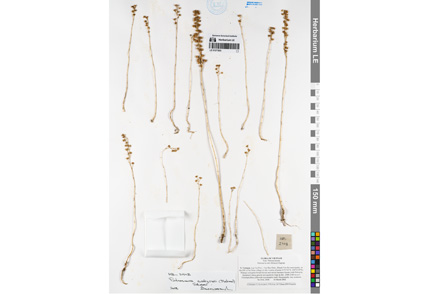Abstract
A reassessment of taxonomy and geographical distribution of a widespread Asian mycoheterotrophic species Petrosavia sakuraii is presented. Petrosavia amamiensis recently described from the Japanese Ryukyu Islands is demonstrated to fit closely the morphological diversity of P. sakuraii. Data from geography, molecular phylogenetics and reproductive biology also provide no substantial evidences in favor of consideration of the specimens of Petrosavia from Ryukyu as a distinct species. Accordingly, P. amamiensis is here reduced to a taxonomic synonym of P. sakuraii. Worldwide distribution range of P. sakuraii is reviewed to summarize the scattered evidences accumulated to date in the forms of herbarium specimens and publications of range extensions. A disjunct distribution pattern is highlighted between the populations in Sumatra and the rest of the species range: P. sakuraii occurs from the Himalayas to the Honshu Island, but within the Indochinese Peninsula it is known only in its northernmost part. Finally, typification of P. sakuraii and its synonym P. sinii is revised, and lectotypes are designated for both names.
References
Beccari, O. (1871) Petrosavia, nuovo genere di piante parassite della famiglia delle Melanthaceae. Nuovo Giornale Botanico Italiano 3: 7–11.
Bhat, N.A., Jeri, L., Roy, D.K. & Kumar, Y. (2018) Petrosaviaceae, a new family record for India. Bangladesh Journal of Plant Taxonomy 25 (1): 113–117. https://doi.org/10.3329/bjpt.v25i1.37188
Cameron, K.M., Chase, M.W. & Rudall, P.J. (2003) Recircumscription of the monocotyledonous family Petrosaviaceae to include Japonolirion. Brittonia 55 (3): 214–225. https://doi.org/10.1663/0007-196X(2003)055[0214:ROTMFP]2.0.CO;2
Chen, X., Liang, S., Xu, J. & Tamura, M.N. (2000) Liliaceae. In: Wu, Z.Y. & Raven, P.H. (Eds.) Flora of China. Vol. 24. Science Press, Beijing, and Missouri Botanical Garden Press, St. Louis, pp. 73–263.
Gagnepain, F. (1934) Liliacées. In: Lecomte, H. (Ed.) Flore Générale de l’Indo-Chine. Vol. 6. Masson et Cie, Paris, pp. 753–815.
Gitzendanner, M.A., Soltis, P.S., Wong, G.K.S., Ruhfel, B.R. & Soltis, D.E. (2018) Plastid phylogenomic analysis of green plants: A billion years of evolutionary history. American Journal of Botany 105 (3): 291–301. https://doi.org/10.1002/ajb2.1048
Givnish, T.J., Zuluaga, A., Spalink, D., Soto Gomez, M., Lam, V.K.Y., Saarela, J.M., Sass, C., Iles, W.J.D., de Sousa, D.J.L., Leebens-Mack, J., Chris Pires, J., Zomlefer, W.B., Gandolfo, M.A., Davis, J.I., Stevenson, D.W., dePamphilis, C., Specht, C.D., Graham, S.W., Barrett, C.F. & Ané, C. (2018) Monocot plastid phylogenomics, timeline, net rates of species diversification, the power of multi-gene analyses, and a functional model for the origin of monocots. American Journal of Botany 105 (11): 1888–1910. https://doi.org/10.1002/ajb2.1178
Hansen, B. & Rasmussen, F. (2005) Petrosaviaceae. In: Santisuk, T. & Larsen, K. (Eds.) Flora of Thailand. Vol. 9 (1). Prachachon Co., Bangkok, pp. 50.
Hu, G.W., Lei, L.G. & Liu, K.M. (2002) Some newly recorded plants from Hunan province of China (IV). Bulletin of Botanical Research 22 (2): 136–138.
Jessop, J.P. (1979) Liliaceae I. In: van Steenis, C.G.G.J. (Ed.) Flora Malesiana. Ser. I, Vol. 9. Sijthoff and Noordhoff, Alphen aan den Rijn, pp. 189–235.
Jin, X. & Mint, Z. (2018) Petrosaviaceae, a new familial record of angiosperm from Myanmar. Journal of Tropical and Subtropical Botany 26 (6): 677–678. https://doi.org/10.11926/jtsb.3897
Krause, K. (1929) Zwei für China neue Liliaceengatlungen. Notizblatt des Botanischen Gartens und Museums zu Berlin-Dahlem 98: 806–807.
Kress, W.J., DeFilipps, R.A., Farr, E. & Kyi, D.Y.Y. (2003) A checklist of the trees, shrubs, herbs and climbers of Myanmar. Contributions from the United States National Herbarium 45: 1–590.
Lam, V.K.Y., Merckx, V.S.F.T. & Graham, S.W. (2016) A few-gene plastid phylogenetic framework for mycoheterotrophic monocots. American Journal of Botany 103 (4): 692–708. https://doi.org/10.3732/ajb.1500412
Lam, V.K.Y., Darby, H., Merckx, V.S.F.T., Lim, G., Yukawa, T., Neubig, K.M., Abbott, J.R., Beatty, G.E., Provan, J., Soto Gomez, M. & Graham, S.W. (2018) Phylogenomic inference in extremis: a case study with mycoheterotroph plastomes. American Journal of Botany 105 (3): 480–494. https://doi.org/10.1002/ajb2.1070
Li, H.T., Luo, Y., Gan, L., Ma, P.F., Gao, L.M., Yang, J.B., Cai, J., Gitzendanner, M.A., Fritsch, P.W., Zhang, T., Jin, J.J., Zeng, C.X., Wang, H., Yu, W.B., Zhang, R., van der Bank, M., Olmstead, R.G., Hollingsworth, P.M., Chase, M.W. & Soltis, D.E. (2021) Plastid phylogenomic insights into relationships of all flowering plant families. BMC biology 19: 232. https://doi.org/10.1186/s12915-021-01166-2
Liu, C., Ya, J., Guo, Y., Cai, J. & Zhang, T. (2020) Newly recorded species of seed plants from Xizang, China. Biodiversity Science 28 (10): 1238–1245. [in Chinese] https://doi.org/10.17520/biods.2020161
Makino, T. (1903) Observations on the flora of Japan. (Continued from p. 121.) Botanical Magazine (Tokyo) 17 (199): en144–en152. https://doi.org/10.15281/jplantres1887.17.199_144
Masamune, G. (1938) Miscellaneous notes on the flora of the eastern Asia. I. Transactions, Natural History Society of Formosa 28: 45–46. [in Japanese]
Nakai, T. (1930) Notulae ad plantas Japoniae & Koreae XXXVIII. Botanical Magazine (Tokyo) 44 (517): 7–40. https://doi.org/10.15281/jplantres1887.44.7
Ohashi, H. (2000) Petrosavia (Petrosaviaceae) in Taiwan and Hainan. Taiwania 45 (3): 263–269. https://doi.org/10.6165/tai.2000.45(3).263
Remizowa, M.V., Nuraliev, M.S., Averyanov, L.V., Kuznetsov, A.N. & Kuznetsova, S.P. (2017) A revision of the family Petrosaviaceae in Vietnam. Nordic Journal of Botany 35 (3): 262–271. https://doi.org/10.1111/njb.01480
Takahashi, H., Nishio, E. & Hayashi, H. (1993) Pollination biology of the saprophytic species Petrosavia sakuraii (Makino) van Steenis in Central Japan. Journal of Plant Research 106 (3): 213–217. https://doi.org/10.1007/BF02344587
Takahashi, H., Yukawa, T. & Maki, M. (2021) A new species, Petrosavia amamiensis (Petrosaviaceae), from Amami-Oshima Island, Kagoshima Prefecture, Japan. Acta Phytotaxonomica et Geobotanica 72 (3): 265–274. https://doi.org/10.18942/apg.202103
Tamura, M.N. (2016) Petrosavia Becc., Japonolirion Nakai. In: Iwatsuki, K., Boufford, D.E. & Ohba, H. (Eds.) Flora of Japan. Vol. IVb. Kodansha LTD, Tokyo, pp. 80–82.
Tanaka, N. & Sugawara, T. (2011) Typification of Dr. Tomitaro Makino’s botanical names (6). Journal of Japanese Botany 86 (3): 139–155.
Turland, N.J., Wiersema, J.H., Barrie, F.R., Greuter, W., Hawksworth, D.L., Herendeen, P.S., Knapp, S., Kusber, W.-H., Li, D.-Z., Marhold, K., May, T.W., McNeill, J., Monro, A.M., Prado, J., Price, M.J. & Smith, G.F. (Eds.) (2018) International Code of Nomenclature for algae, fungi, and plants (Shenzhen Code) adopted by the Nineteenth International Botanical Congress Shenzhen, China, July 2017. [Regnum Vegetabile 159]. Koeltz Botanical Books, Glashütten. https://doi.org/10.12705/Code.2018
van Steenis, C.G.G.J. (1934) Determinate-tabel voor de Nederlandsch Indische Bladgroenlooze Phanerogamen. De Tropische Natuur 23: 45–57.


